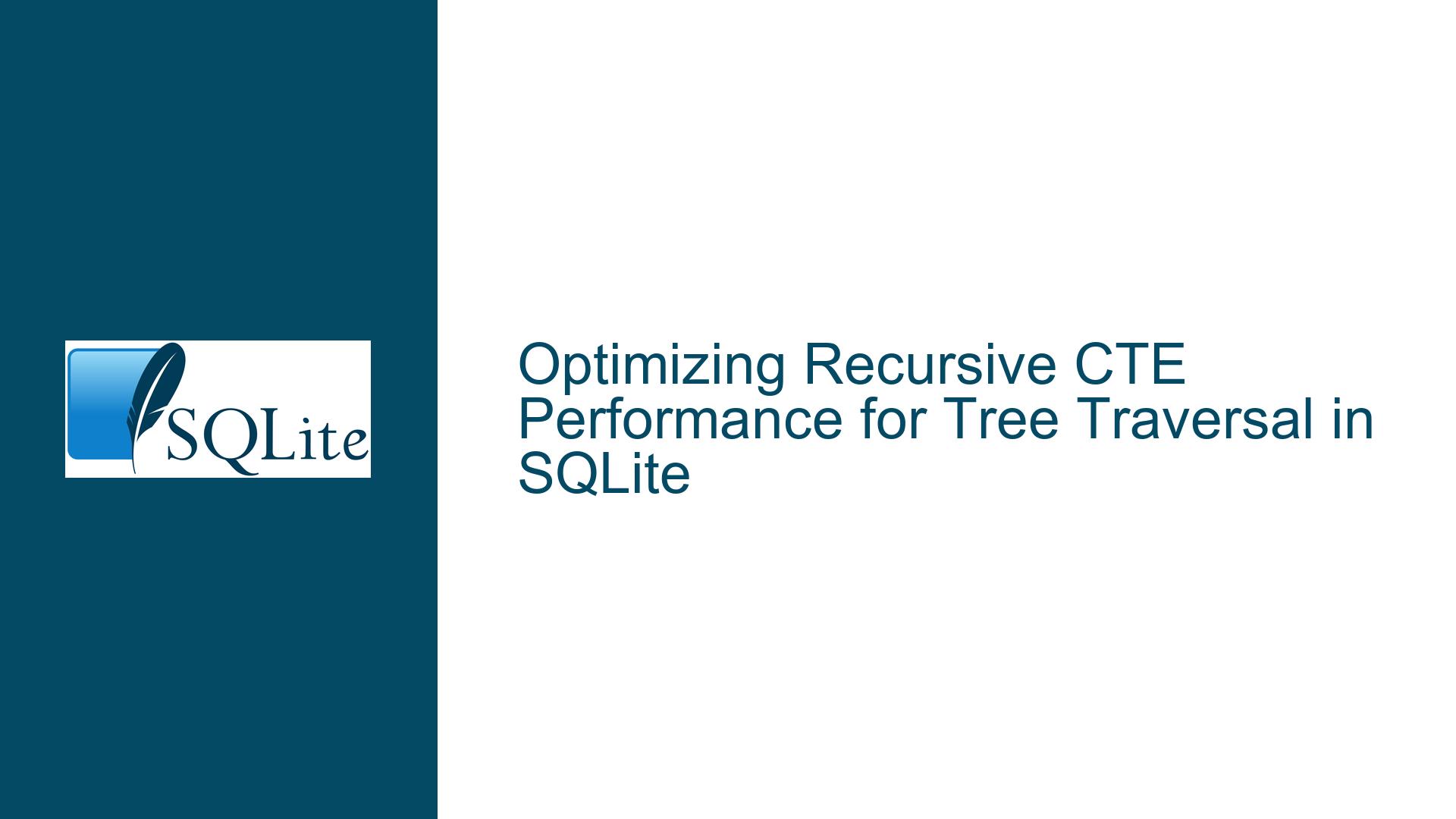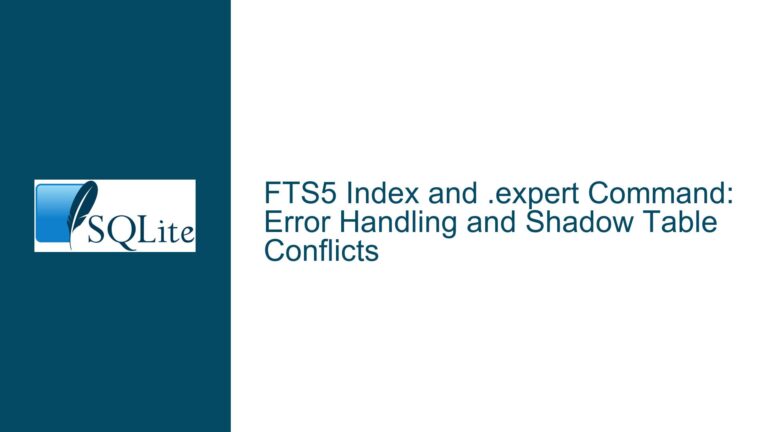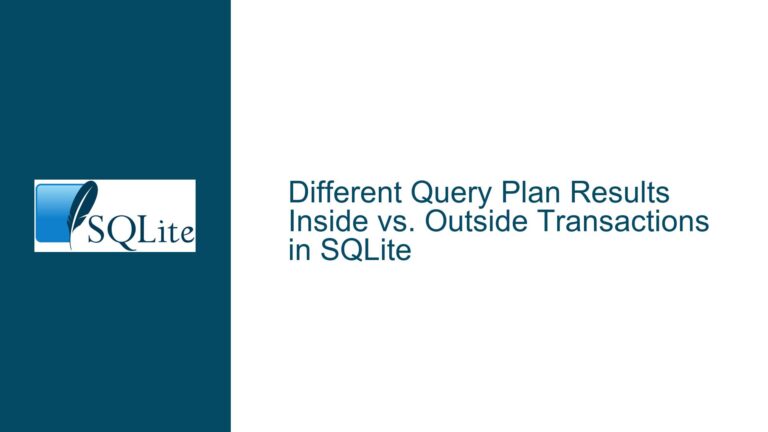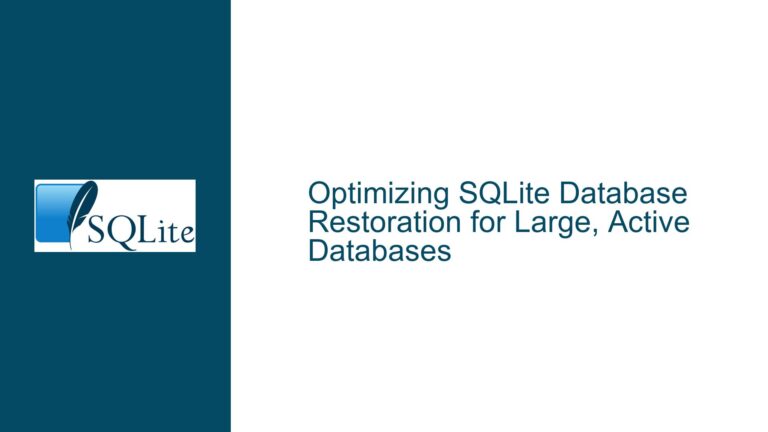Optimizing Recursive CTE Performance for Tree Traversal in SQLite
Understanding Recursive CTE Performance Limitations in Hierarchical Data Aggregation
The scenario involves calculating the sum of all descendant node IDs under a root node in a ten-fork tree structure stored in SQLite. The tree has a height of 6 and contains 1,000,001 nodes. Two methods were tested for this calculation: a recursive Common Table Expression (CTE) and a manual join approach using multiple CTE layers. The recursive CTE took 0.63 seconds, while the manual join completed in 0.36 seconds (or 0.24 seconds with NOT MATERIALIZED hints). The root cause of this performance disparity lies in SQLite’s execution strategy for recursive CTEs compared to static join hierarchies.
The tree structure is stored in a table tree with columns pid (parent ID), id (node ID), and is_leaf (a boolean-like flag). The recursive CTE traverses the tree by repeatedly joining child nodes to parent nodes until leaf nodes are reached. The manual join method explicitly defines each level of the hierarchy (lv1 to lv7) using cascading CTEs, allowing SQLite to optimize each join step independently. This bypasses the overhead of recursion control mechanisms and enables better use of indexing and query planning.
Key observations include:
- Execution Plan Differences: The recursive CTE generates a dynamic execution plan that processes rows iteratively, while the manual join creates a static plan with predetermined joins.
- Materialization Overhead: By default, SQLite may materialize intermediate CTE results, adding memory and CPU costs. The
NOT MATERIALIZEDhint reduces this by keeping results in transient storage. - Index Utilization: The manual join approach benefits from predictable index usage patterns, whereas recursive CTEs may fail to leverage indexes optimally at deeper recursion levels.
- Termination Conditions: The
is_leafcheck in the recursive CTE’sWHERE NOT a.is_leafclause introduces per-row evaluation overhead, which is absent in the manual join’s fixed-depth structure.
Factors Contributing to Recursive CTE Inefficiency in Tree Traversal
1. Row-by-Row Iteration in Recursive CTE Execution
SQLite processes recursive CTEs using a breadth-first search (BFS) strategy. Each iteration of the CTE processes one level of the tree at a time. However, this involves repeated scans of the tree table for each parent node’s children. In contrast, the manual join predefines all levels (lv1 to lv7), allowing SQLite to optimize each level’s query plan independently. For example:
- The manual join’s
lv2CTE can exploit an index onpidfor theb.pid = a.idjoin. - The recursive CTE’s
CROSS JOIN tree b ON b.pid = a.idmust re-evaluate the join condition for every row generated in the previous iteration, leading to redundant index lookups or full scans.
2. Materialization of Intermediate Results
By default, SQLite materializes CTE results into temporary storage. For recursive CTEs, this means each iteration’s results are stored in a temporary table, which is then read in the next iteration. Materialization ensures correctness in complex recursion but adds overhead from temporary table creation and disk I/O. The manual join avoids this by using NOT MATERIALIZED hints, forcing SQLite to treat CTEs as inline views. This reduces memory usage and allows the query planner to merge CTE logic into the main query.
3. Indexing Gaps and Join Condition Optimization
The tree table’s primary key is (pid, id), which provides an index on pid (since it’s the first column). However, recursive CTEs may fail to use this index efficiently due to:
- Predicate Pushdown Limitations: The
WHERE NOT a.is_leafcondition in the recursive CTE’s join clause may prevent the optimizer from using thepidindex optimally. - Dynamic Depth Uncertainty: The recursive CTE’s depth is unknown at compile time, making it harder for SQLite to estimate cardinality and choose optimal join strategies. The manual join’s fixed depth allows precise cardinality estimates.
4. Leaf Node Check Overhead
The is_leaf column is used to terminate recursion early. However, in the recursive CTE, the condition WHERE NOT a.is_leaf is evaluated for every row in each iteration. This adds CPU overhead compared to the manual join, which implicitly terminates at level 7 (the tree’s fixed height). For trees with variable depths, the manual join approach would fail, but in this case, it exploits prior knowledge of the structure.
Strategies for Bridging the Performance Gap Between Recursive CTEs and Manual Joins
1. Optimize Indexing for Recursive Traversal
Action: Create a composite index on (pid, is_leaf) to accelerate both parent-child joins and leaf checks.
Rationale: The recursive CTE’s join condition b.pid = a.id and filter NOT a.is_leaf can be satisfied with a single index lookup.
Implementation:
CREATE INDEX idx_tree_pid_is_leaf ON tree(pid, is_leaf);
Testing: After adding the index, re-run the recursive CTE. The execution time should decrease as SQLite can now resolve pid and is_leaf checks without scanning the entire table.
2. Use NOT MATERIALIZED Hints in Recursive CTEs
Action: Modify the recursive CTE to prevent materialization of intermediate results.
Rationale: Materialization introduces temporary table overhead, which is unnecessary for tree traversal where results are consumed immediately.
Implementation:
WITH RECURSIVE
descendant(id, is_leaf) AS (
SELECT id, is_leaf
FROM tree
WHERE pid = 0
UNION ALL
SELECT b.id, b.is_leaf
FROM descendant a
CROSS JOIN tree b ON b.pid = a.id
WHERE NOT a.is_leaf
)
SELECT SUM(id)
FROM descendant
NOT MATERIALIZED; -- Hypothetical syntax (SQLite does not support this directly)
Note: SQLite does not support NOT MATERIALIZED hints for recursive CTEs. Instead, force inline evaluation by limiting CTE complexity or splitting the query.
3. Precompute Tree Depth or Use Closure Tables
Action: Implement a closure table or precompute ancestor-descendant relationships.
Rationale: Closure tables store all (ancestor, descendant, depth) relationships upfront, enabling O(1) lookups for descendants.
Implementation:
- Create a closure table:
CREATE TABLE closure (
ancestor INT,
descendant INT,
depth INT,
PRIMARY KEY (ancestor, descendant)
);
- Populate it using triggers or batch jobs.
- Query descendants directly:
SELECT SUM(descendant)
FROM closure
WHERE ancestor = 0;
Trade-offs: Closure tables increase storage and maintenance costs but eliminate runtime traversal overhead.
4. Hybrid Approach: Limit Recursion Depth
Action: Combine recursive CTEs with manual joins for deeper levels.
Rationale: Use recursion for the first few levels and switch to manual joins for lower levels where indexing becomes less effective.
Implementation:
WITH RECURSIVE
descendant_lv1to3(id, is_leaf) AS (
SELECT id, is_leaf FROM tree WHERE pid = 0
UNION ALL
SELECT b.id, b.is_leaf
FROM descendant_lv1to3 a
JOIN tree b ON b.pid = a.id
WHERE NOT a.is_leaf AND depth < 3 -- Hypothetical depth counter
),
lv4(id, is_leaf) AS (
SELECT b.id, b.is_leaf
FROM descendant_lv1to3 a
JOIN tree b ON b.pid = a.id
WHERE NOT a.is_leaf
),
... -- Define lv5, lv6, lv7 similarly
5. Batch Processing with Temporary Tables
Action: Materialize intermediate results into temporary tables at each recursion level.
Rationale: Reduces redundant computation by persisting results for each level.
Implementation:
CREATE TEMP TABLE lv1 AS SELECT id, is_leaf FROM tree WHERE pid = 0;
CREATE TEMP TABLE lv2 AS SELECT b.id, b.is_leaf FROM lv1 a JOIN tree b ON b.pid = a.id WHERE NOT a.is_leaf;
...
SELECT SUM(id) FROM (SELECT id FROM lv1 UNION ALL ...);
Trade-offs: Increases storage and setup time but provides explicit control over intermediate results.
6. Leverage SQLite’s WITHOUT ROWID Optimization
Action: Convert the tree table to a WITHOUT ROWID table with a clustered index.
Rationale: WITHOUT ROWID tables store data in index order, speeding up parent-child joins.
Implementation:
CREATE TABLE tree (
pid INT,
id INT,
is_leaf INT,
PRIMARY KEY (pid, id)
) WITHOUT ROWID;
7. Query Plan Analysis and Manual Optimization
Action: Use EXPLAIN QUERY PLAN to diagnose inefficiencies.
Steps:
- Run
EXPLAIN QUERY PLANon the recursive CTE to identify full scans or missed indexes. - Compare with the manual join’s query plan to spot optimization opportunities.
- Adjust the recursive CTE’s structure to mimic the manual join’s plan (e.g., breaking into subqueries).
8. Application-Side Caching or Preprocessing
Action: Cache descendant IDs for frequently accessed nodes in the application layer.
Rationale: Offload traversal work to application logic, reducing database load.
Implementation:
- Periodically precompute descendant sums and store them in a summary table.
- Use triggers to update the summary table when the tree changes.
9. Version-Specific Optimizations
Action: Exploit SQLite version-specific features (e.g., newer versions have improved CTE optimizations).
Check: Verify if the SQLite instance uses version 3.35.0+ (2021-03-12), which introduced performance improvements for CTEs.
By systematically addressing indexing, materialization policies, and execution strategies, developers can narrow the performance gap between recursive CTEs and manual joins in SQLite. The optimal approach depends on the tree’s depth, query frequency, and update patterns. For static hierarchies, closure tables or hybrid methods are ideal. For dynamic trees, indexed recursive CTEs with careful optimization provide a balance between flexibility and speed.






